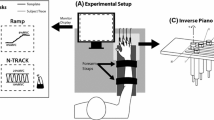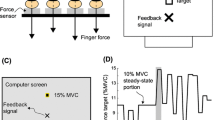Abstract
Stability is the ability of a system to maintain a desired static or dynamic motor pattern. Maneuverability, on the other hand, is the ability to transition between motor patterns, and it is antagonistic to stability. Animals frequently reduce the stability of an ongoing task to facilitate anticipated movement transitions. Such stability–maneuverability tradeoffs are observed in human locomotion. However, the notion applies to other behaviors and this paper reports the first study on the stability–maneuverability tradeoff in human prehension. We tested if the coordination between the digit forces during the manipulation of a hand-held object is altered in response to an expected change in the manipulation pattern. We focused on the coupling between the grip and the load force and between the opposing forces exerted by the thumb and the four fingers, and on the transition from rhythmic vertical oscillation to non-vertical oscillation of the object. The nature of these couplings depends on the oscillation direction. Therefore, the stability–maneuverability tradeoff predicts that an expected volitional change to the object’s movement will diminish the strength of these couplings so that the force patterns generating the current movement can efficiently transition into new ones that generate the new movement. The strength of the grip–load coupling did not alter in tasks that required a change in movement compared to tasks that did not. We speculate that participants preferred safety over maneuverability and maintained the grip–load coupling strength to counter high inertial loads and avoid object slip. In contrast, the strength of the coupling between the thumb and the four fingers’ opposing forces reduced in tasks that required a change in movement compared to tasks that did not. Thus, the stability-reduction aspect of the stability–maneuverability tradeoff occurs in prehensile behavior. Future work should focus on associating the reduction in stability with gains in maneuverability, and on developing a comprehensive account of this tradeoff in prehensile tasks.






Similar content being viewed by others
References
Abarbanel H, Brown R, Sidorowich J, Tsimring L (1993) The analysis of observed chaotic data in physical systems. Rev Mod Phys 65:1331–1392. https://doi.org/10.1103/RevModPhys.65.1331
Acasio J, Wu M, Fey NP, Gordon KE (2017) Stability–maneuverability trade-offs during lateral steps. Gait Posture 52:171–177. https://doi.org/10.1016/j.gaitpost.2016.11.034
Ambike S, Zhou T, Zatsiorsky VM, Latash ML (2015) Moving a hand-held object: reconstruction of referent coordinate and apparent stiffness trajectories. Neuroscience 298:336–356. https://doi.org/10.1016/j.neuroscience.2015.04.023
Arbib MA, Iberall T, Lyons D (1985) Coordinated control programs for movements of the hand. Exp Brain Res Suppl 10:111–129
Blank R, Breitenbach A, Nitschke M, Heizer W, Letzgus S, Hermsdorfer J (2001) Human development of grip force modulation relating to cyclic movement-induced inertial loads. Exp Brain Res 138:193–199. https://doi.org/10.1007/s002210000622
Dakin R, Segre PS, Straw AD, Altshuler DL (2018) Morphology, muscle capacity, skill, and maneuvering ability in hummingbirds. Science 359:653–657. https://doi.org/10.1126/science.aao7104
Danion F (2004) How dependent are grip force and arm actions during holding an object? Exp Brain Res 158:109–119. https://doi.org/10.1007/s00221-004-1882-5
Fish FE (2002) Balancing requirements for stability and maneuverability in cetaceans. Integr Comp Biol 42:85–93. https://doi.org/10.1093/icb/42.1.85
Flanagan JR, Tresilian J, Wing AM (1993) Coupling of grip force and load force during arm movements with grasped objects. Neurosci Lett 152:53–56. https://doi.org/10.1016/0304-3940(93)90481-y
Flanagan JR, Tresilian JR (1994) Grip–load force coupling: a general control strategy for transporting objects. J Exp Psychol Hum Percept Perform 20:944–957. https://doi.org/10.1037/0096-1523.20.5.944
Flanagan JR, Wing AM (1993) Modulation of grip force with load force during point-to-point arm movements. Exp Brain Res 95:131–143
Flanagan JR, Wing AM (1995) The stability of precision grip forces during cyclic arm movements with a hand-held load. Exp Brain Res 105:455–464. https://doi.org/10.1007/bf00233045
Flanagan JR, Wing AM (1997) The role of internal models in motion planning and control: evidence from grip force adjustments during movements of hand-held loads. J Neurosci 17:1519–1528
Fu Q, Zhang W, Santello M (2010) Anticipatory planning and control of grasp positions and forces for dexterous two-digit manipulation. J Neurosci 30:9117–9126. https://doi.org/10.1523/JNEUROSCI.4159-09.2010
Gao F, Latash ML, Zatsiorsky VM (2005) Internal forces during object manipulation. Exp Brain Res 165:69–83. https://doi.org/10.1007/s00221-005-2282-1
Gordon AM, Westling G, Cole KJ, Johansson RS (1993) Memory representations underlying motor commands used during manipulation of common and novel objects. J Neurophysiol 69:1789–1796. https://doi.org/10.1152/jn.1993.69.6.1789
Gorniak SL, Zatsiorsky VM, Latash ML (2009) Hierarchical control of static prehension: II. Multi-digit synergies. Exp Brain Res 194:1–15. https://doi.org/10.1007/s00221-008-1663-7
Grover F, Lamb M, Bonnette S, Silva PL, Lorenz T, Riley MA (2018) Intermittent coupling between grip force and load force during oscillations of a hand-held object. Exp Brain Res 236:2531–2544. https://doi.org/10.1007/s00221-018-5315-2
Grover FM, Nalepka P, Silva PL, Lorenz T, Riley MA (2019) Variable and intermittent grip force control in response to differing load force dynamics. Exp Brain Res 237:687–703. https://doi.org/10.1007/s00221-018-5451-8
Hadjiosif AM, Smith MA (2015) Flexible control of safety margins for action based on environmental variability. J Neurosci 35:9106–9121. https://doi.org/10.1523/JNEUROSCI.1883-14.2015
Hasan Z (2005) The human motor control system's response to mechanical perturbation: should it, can it, and does it ensure stability? J Mot Behav 37:484–493. https://doi.org/10.3200/JMBR.37.6.484-493
Hasson CJ, Van Emmerik RE, Caldwell GE, Haddad JM, Gagnon JL, Hamill J (2008) Influence of embedding parameters and noise in center of pressure recurrence quantification analysis. Gait Posture 27:416–422. https://doi.org/10.1016/j.gaitpost.2007.05.010
Hermsdorfer J, Blankenfeld H (2008) Grip force control of predictable external loads. Exp Brain Res 185:719–728. https://doi.org/10.1007/s00221-007-1195-6
Hick WE (1952) On the rate of gain of information. Q J Exp Psychol 4:11–26
Huang HJ, Ahmed AA (2011) Tradeoff between stability and maneuverability during whole-body movements. PLoS ONE. https://doi.org/10.1371/journal.pone.0021815
Hyman R (1953) Stimulus information as a determinant of reaction time. J Exp Psychol 45:188–196
Johansson RS, Flanagan JR (2009) Coding and use of tactile signals from the fingertips in object manipulation tasks. Nat Rev Neurosci 10:345–359. https://doi.org/10.1038/nrn2621
Johansson RS, Westling G (1984) Roles of glabrous skin receptors and sensorimotor memory in automatic control of precision grip when lifting rougher or more slippery objects. Exp Brain Res 56:550–564
Kantz H, Schreiber T (1997) Nonlinear time series analysis. Cambridge University Press, Cambridge
Kerr J, Roth B (1986) Analysis of multifingered hands. Int J Robot Res 4:3–17. https://doi.org/10.1177/027836498600400401
Kording KP, Wolpert DM (2004) Bayesian integration in sensorimotor learning. Nature 427:244–247. https://doi.org/10.1038/nature02169
Kuling IA, Salmen F, Lefevre P (2019) Grip force preparation for collisions. Exp Brain Res 237:2585–2594. https://doi.org/10.1007/s00221-019-05606-y
Mandelbrot BB (1982) The fractal geometry of nature. Freeman, San Fransisco
Marwan N (2011) How to avoid potential pitfalls in recurrence plot based data analysis. Int J Bifurc Chaos 21:1003–1017. https://doi.org/10.1142/s0218127411029008
Marwan N, Kurths J (2002) Nonlinear analysis of bivariate data with cross recurrence plots. Phys Lett A 302:299–307. https://doi.org/10.1016/S0375-9601(02)01170-2
Nashed JY, Diamond JS, Gallivan JP, Wolpert DM, Flanagan JR (2017) Grip force when reaching with target uncertainty provides evidence for motor optimization over averaging. Sci Rep 7:11703. https://doi.org/10.1038/s41598-017-10996-6
Olafsdottir H, Yoshida N, Zatsiorsky VM, Latash ML (2005) Anticipatory covariation of finger forces during self-paced and reaction time force production. Neurosci Lett 381:92–96. https://doi.org/10.1016/j.neulet.2005.02.003
Olafsdottir H, Zhang W, Zatsiorsky VM, Latash ML (2007) Age-related changes in multifinger synergies in accurate moment of force production tasks. J Appl Physiol 102:1490–1501. https://doi.org/10.1152/japplphysiol.00966.2006
Olafsdottir HB, Kim SW, Zatsiorsky VM, Latash ML (2008) Anticipatory synergy adjustments in preparation to self-triggered perturbations in elderly individuals. J Appl Biomech 24:175–179
Pilon JF, De Serres SJ, Feldman AG (2007) Threshold position control of arm movement with anticipatory increase in grip force. Exp Brain Res 181:49–67. https://doi.org/10.1007/s00221-007-0901-8
Quaney BM, Rotella DL, Peterson C, Cole KJ (2003) Sensorimotor memory for fingertip forces: evidence for a task-independent motor memory. J Neurosci 23:1981–1986
Riccio GE (1993) Information in movement variability about quantitative dynamics of posture and orientation. In: Newell KMCD (ed) Variability and motor control. Human Kinetics, Champaign, pp 317–357
Riccio GE, Stoffregen TA (1988) Affordances as constraints on the control of stance. Hum Mov Sci 7:265–300
Riley MA, Turvey MT (2002) Variability of determinism in motor behavior. J Mot Behav 34:99–125. https://doi.org/10.1080/00222890209601934
Santisteban L, Teremetz M, Bleton JP, Baron JC, Maier MA, Lindberg PG (2016) Upper limb outcome measures used in stroke rehabilitation studies: a systematic literature review. PLoS ONE 11:e0154792. https://doi.org/10.1371/journal.pone.0154792
Scholz JP, Latash ML (1998) A study of a bimanual synergy associated with holding an object. Hum Mov Sci 17:753–779
Shim JK, Olafsdottir H, Zatsiorsky VM, Latash ML (2005) The emergence and disappearance of multi-digit synergies during force-production tasks. Exp Brain Res 164:260–270. https://doi.org/10.1007/s00221-005-2248-3
Shim JK, Park J, Zatsiorsky VM, Latash ML (2006) Adjustments of prehension synergies in response to self-triggered and experimenter-triggered load and torque perturbations. Exp Brain Res 175:641–653. https://doi.org/10.1007/s00221-006-0583-7
Slota GP, Latash ML, Zatsiorsky VM (2011) Grip forces during object manipulation: experiment, mathematical model, and validation. Exp Brain Res 213:125–139. https://doi.org/10.1007/s00221-011-2784-y
Tillman M, Ambike S (2018a) Cue-induced changes in the stability of finger force-production tasks revealed by the uncontrolled manifold analysis. J Neurophysiol 119:21–32. https://doi.org/10.1152/jn.00519.2017
Tillman M, Ambike S (2018b) Expectation of movement generates contrasting changes in multifinger synergies in young and older adults. Exp Brain Res 236:2765–2780. https://doi.org/10.1007/s00221-018-5333-0
Viviani P, Lacquaniti F (2015) Grip forces during fast point-to-point and continuous hand movements. Exp Brain Res 233:3201–3220. https://doi.org/10.1007/s00221-015-4388-4
Webber CL Jr, Zbilut JP (1994) Dynamical assessment of physiological systems and states using recurrence plot strategies. J Appl Physiol 1985 76:965–973. https://doi.org/10.1152/jappl.1994.76.2.965
Wolpert DM, Landy MS (2012) Motor control is decision-making. Curr Opin Neurobiol 22:996–1003. https://doi.org/10.1016/j.conb.2012.05.003
Yoshikawa T, Nagai K (1991) Manipulation and grasping forces in manipulation by multifingered robot hands. IEEE Trans Robot Autom 7:67–77. https://doi.org/10.1109/70.68071
Zbilut JP, Thomasson N, Webber CL (2002) Recurrence quantification analysis as a tool for nonlinear exploration of nonstationary cardiac signals. Med Eng Phys 24:53–60
Zhou T, Wu YH, Bartsch A, Cuadra C, Zatsiorsky VM, Latash ML (2013) Anticipatory synergy adjustments: preparing a quick action in an unknown direction. Exp Brain Res 226:565–573. https://doi.org/10.1007/s00221-013-3469-5
Author information
Authors and Affiliations
Corresponding author
Additional information
Communicated by Francesco Lacquaniti.
Publisher's Note
Springer Nature remains neutral with regard to jurisdictional claims in published maps and institutional affiliations.
Rights and permissions
About this article
Cite this article
Naik, A., Ambike, S. The coordination between digit forces is altered by anticipated changes in prehensile movement patterns. Exp Brain Res 238, 1145–1156 (2020). https://doi.org/10.1007/s00221-020-05783-1
Received:
Accepted:
Published:
Issue Date:
DOI: https://doi.org/10.1007/s00221-020-05783-1




